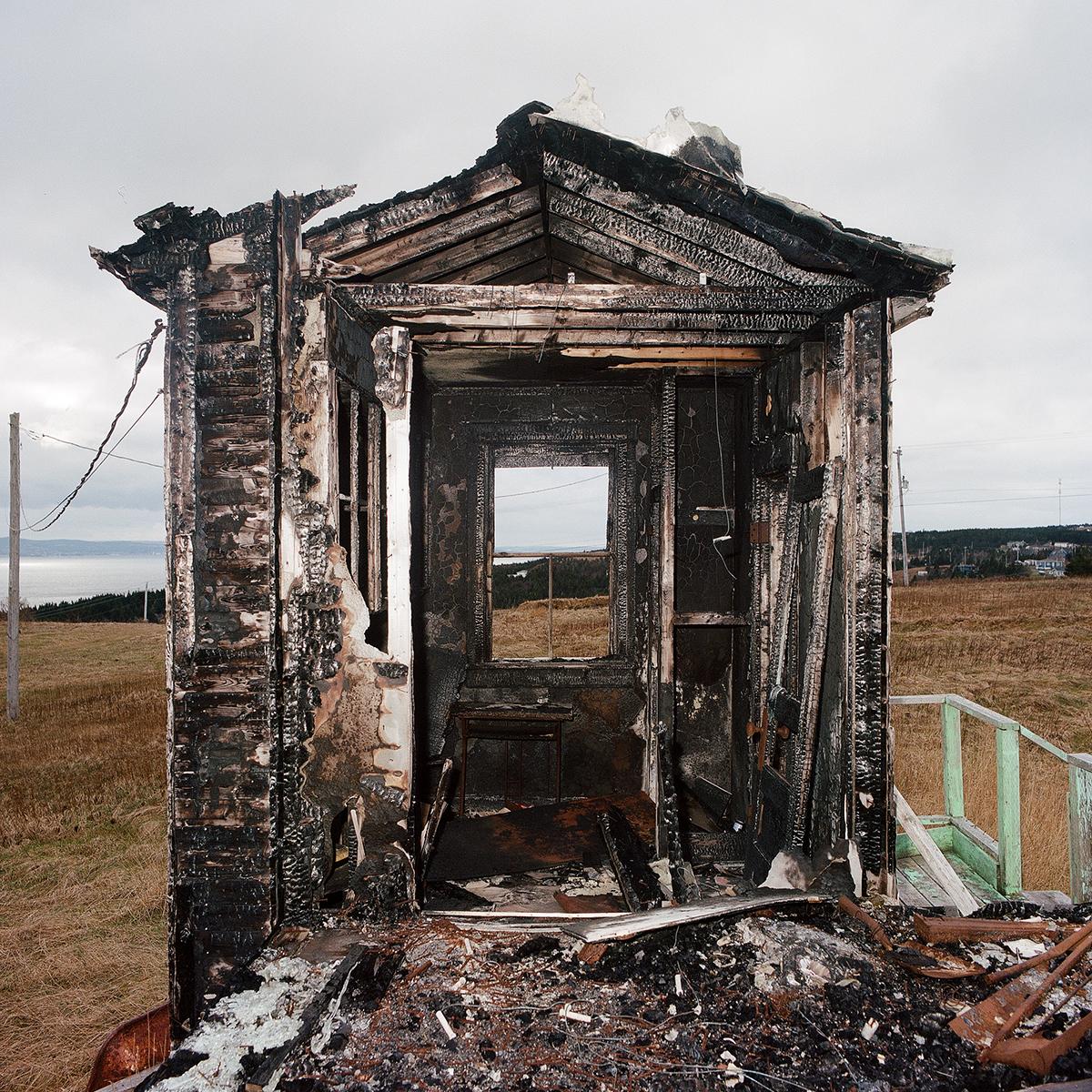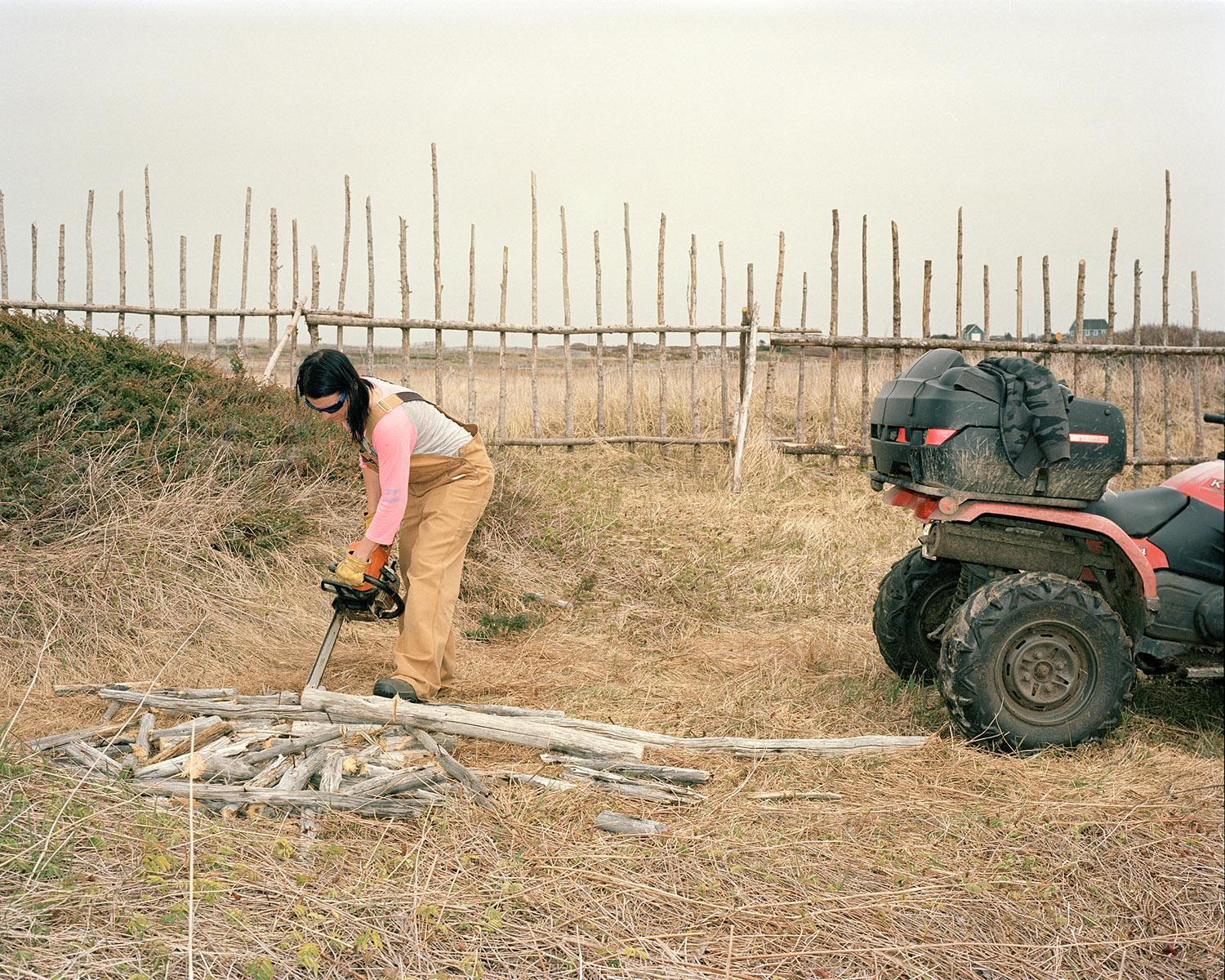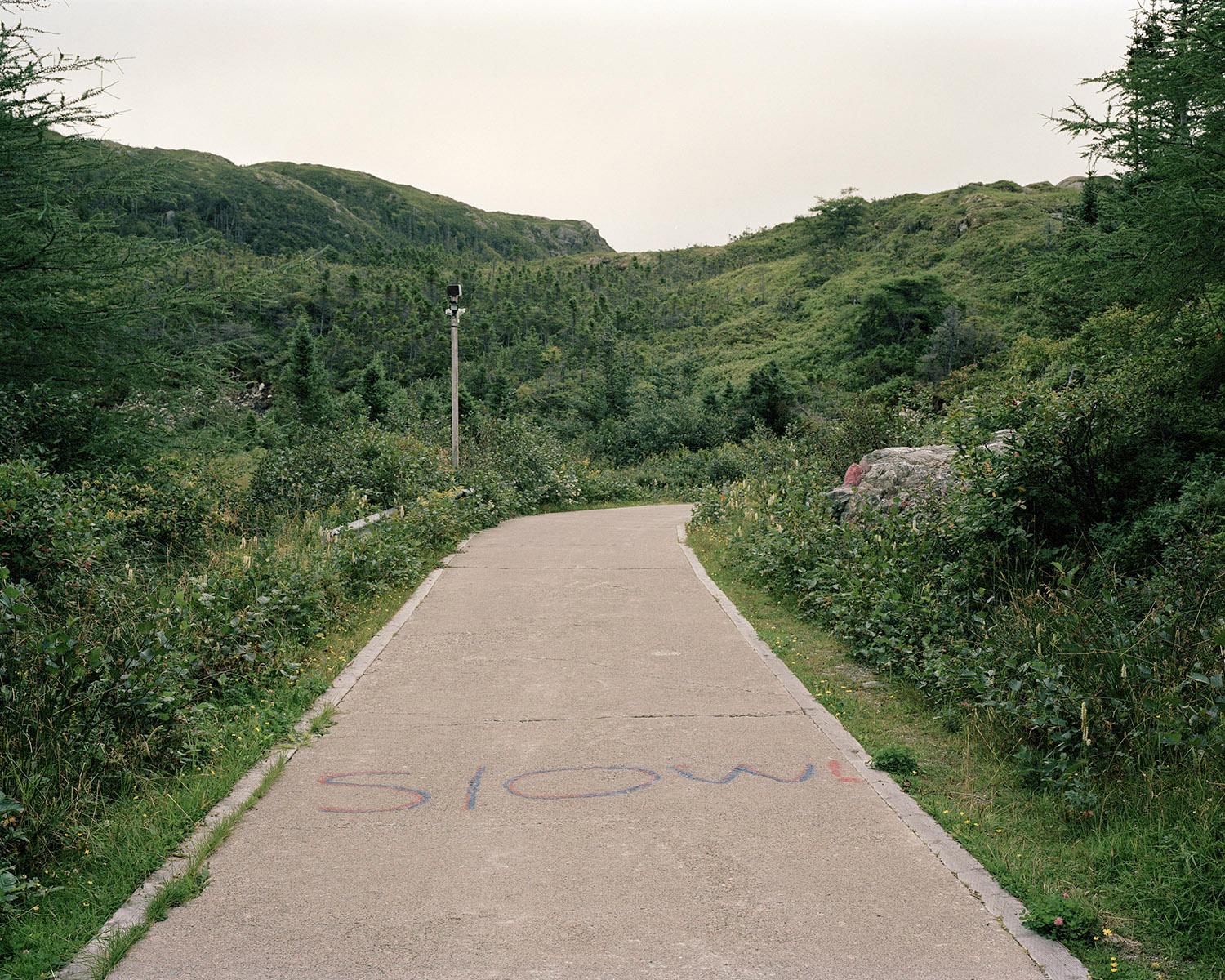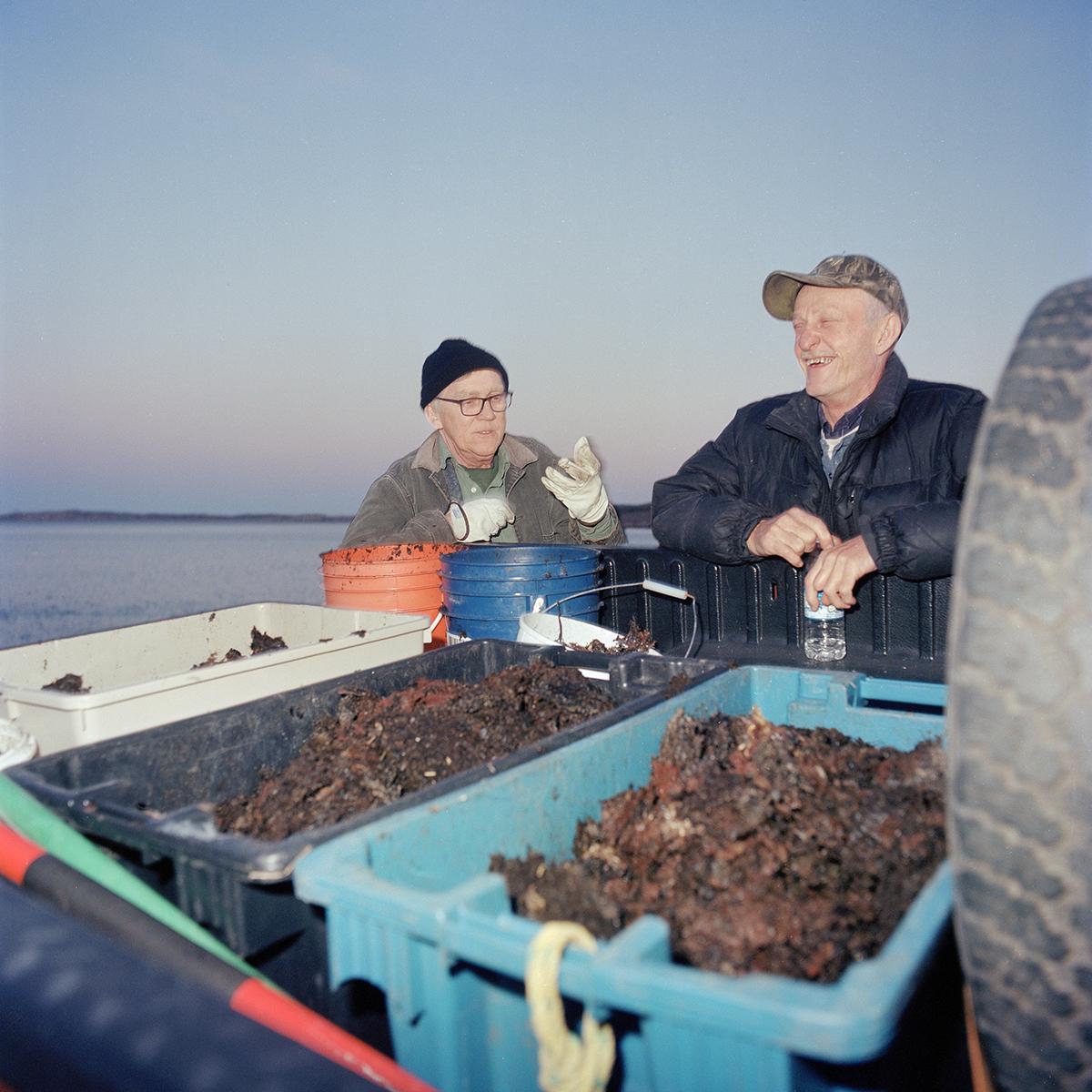A code of conduct is a list. It can be short or long, normally between five to seven points. It enumerates a certain set of behaviours that are appropriate in a given setting. Sometimes behaviours that are not appropriate are listed too. It is sort of the x and y of socialisation. It plots a space between appropriate and inappropriate behaviour. But it is entirely movable and depends on a given situation, so some would say that it’s site-specific.
The first time I meet artist, Ethan Murphy is on a Zoom call sometime in late 2021, but technically the second time we meet in person is on Fogo Island in Newfoundland & Labrador. I wait for him in an unmarked parking lot in Joe Batt’s Arm and he arrives fresh off the ferry in a 2004 red Toyota Tacoma, blasting music and a large smile.
An apt way of describing our relationship would be to call it site-specific too. We worked together closely on an exhibition that came about in 2022. A duo show of Murphy's work along with Labrador-born Tanea Hynes shown on Fogo Island through Fogo Island Arts. The show was called The Shape of Desire and made use of the idea of desire to consider the legacy of romanticism and its discontent in image-making but particularly as it exists against the backdrop of harsh socio-economic realities facing the province of Newfoundland & Labrador. Much of Murphy's work in the exhibition took its aim at documenting exchanges between identity and loss, specifically reconstituting his own account of loss through an image-making process. Series like where the light shines first & what’s left & what’s gathered are examples of this.
Since 2022, Murphy and I have visited each other on Fogo Island, in St Johns, including a brief trip to Bell Island, where the artist’s father grew up and now where the skeleton of his house remains; victim to an arson hobby popular amongst some of the younger islanders. Over trips and car rides, we have talked about the significance of visual culture and recorded history in Newfoundland. Photography set in an environment largely dominated by imagery suited towards the tourist economy produces a particular object relation; much of our conversations have considered how behaviours - or more formally “methodologies” - can, if at all, unsettle this terrain.
When I first met St John’s based artist Pam Hall in 2021 in Tilting on Fogo Island she was explicit about methodology being at the centre of artistic practice. “Methodology is everything, that's the work, that's all you have”. This feels especially true in a province like Newfoundland & Labrador where the economy booms and busts almost overnight. Between the poor state of inshore fishery, the decline of the paper mill industry, the tumultuous labour of the mining industry, now more creative solutions around offshore work and rotational work in Alberta are more popular and more lucrative offerings but those still face precarity too. Offshore and rotational work requires constant and reliable routes of transportation in and out of the province.These routes shuttered completely during the pandemic and three years later are still notoriously unreliable due to layoffs, weather, “demand”, and the price point, which is often more expensive than an aeroplane ticket to Paris, France.
It's to say that extractive mediums magnify the conditions they seek to highlight for a moment. They render realities, conditions of class, or economic insecurities into a single frame, yet how they arrive there is predominantly invisible. Newfoundland, in particular, teeters between an economy built around a romantic notion of tradition and a crashing socio-economic reality. Any product of this environment negotiates aspects of performance and desire in the face of the real.
Murphy’s current project is an ongoing series of photographs that takes ferry-access communities throughout Newfoundland as its main subject. Since January 2022, he has travelled to nine ferry-access communities in the province: St Brendan’s, Fogo Island, Long Island, South East Bight, Rencontre East, Gaultois, Grey River, Ramea and Bell Island. The project takes its inspiration from what remains. Since the 1992 cod moratorium and the decline of industrialization, much has been lost in small communities and the rates of emigration are tremendous but cultural identities and self-sufficient ways of living continue to prosper in new forms. Some are passed down through families and others are adopted eagerly by those who now call Newfoundland home. Now, many of these communities face resettlement - a political project of the provincial government that comes from the less-than-thriving economy, the declining, ageing population and the cost of keeping the few services left available. This year, Murphy will continue to: McCallum, François, La Poile & Change Islands.
Murphy is a photographer born and raised in St. John’s, Newfoundland who earned a BFA from Toronto Metropolitan University in 2019 and shortly thereafter returned to St. John’s where he is now based.
The point of the work is to engage viewers in their own politics, their own understanding of place and their assumptions.
Do you think your practice has changed a lot since we opened the exhibit, The Shape of Desire in April 2022?
Yes, I would almost say in an extreme way actually. That was when Zita Cobb asked me the question about whether I was optimistic about Newfoundland. That was the driving question behind this newer work.
What did you reply?
I basically said “who cares what I think. My individual opinion is insignificant.” What I think is much more interesting is posing that question visually. For me, photography has a very open-ended quality. I am not interested in making work that is extremely didactic. When I begin making new work, I like to start by asking a lot of questions. Photography is a line of enquiry and I am interested in asking that question about optimism visually instead of giving my opinion. What was also interesting about that comment was that it came up during a talk on the occasion of that exhibition. Nicolaus Schafhausen, one of the curators, was asking me what would come after the exhibition. I started thinking about the opposite of what I had been doing for the last three to four years prior. I was really trying to flesh out the question of what does optimism look like? A lot of the work prior to that exhibition was focused on the absence of, the loss of, the decay of, things that were quite pessimistic. I was always interested in a positive outcome from grief, or loss, and change as a kind of rethinking of sorts. So I was interested in the more tangible side of optimism and spending time on Fogo Island, especially in Oliver’s Cove in the gardens was a huge starting point for that. It was also in conjunction with this question about why Fogo Island and Bell Island feel so similar, even though they couldn’t be more different. But of course, they are both islands, they have this detachment, fewer services, fewer amenities, etc. They are on their own but they make it work. The places I chose to focus on have very real challenges and obstacles, it is a difficult and challenging way of life.

Dad's House #2, 2021. Courtesy of the artist.
What strikes me now about that exhibition is that I would characterise the work you showed as deeply personal: images of your father’s burnt down house on Bell Island, the inside of your cabin, friends, there was a photo of you too. The ferry-access communities project is almost the opposite. The photographs are not of people you know, or of places you know, or have any particular relationship with.
Yes, although I want to know them and to get to know them. I see building genuine relationships as a sincere way to think about these ideas.The work in that exhibition was about relating my personal experience to an open-ended narrative. Next, there was this initial urge to think about places in Newfoundland and previous histories on a larger scale but I wanted to do something that was not about my personal experience. What unites both is the specificity of the environment. I made the more personal work when I was living outside of the province in Toronto. So my perspective of Newfoundland acted as a starting point. Now I live in St John’s and I have the opportunity to visit some of the most isolated, remote areas of Newfoundland. I am getting more and more specific about what I want to make work about. Ultimately, the personal work came about because I wanted to begin with something I was deeply familiar with and felt was coming from a very genuine place.
I recently had a conversation with a friend who teaches art at a university about what kind of work current students are producing. I was asking about whether personal experience was at the core of much of the work that was coming out of the present moment. And the answer was yes. In this present moment, it is a beginning and it is a way of establishing a voice for yourself from experience and one that feels genuine. But on the other hand, anything grounded in experience has clearer limitations around the “knowable” as being only possible via lived understanding. I think there is a good moment to move past the individual and think more collectively. What strikes me is that the shift between making work about individual versus collective experience requires a more serious engagement with methodology. It is not just yourself anymore, it's also to do with others and other realities, and it's an added layer of complexity to engage with.
When it comes to making work about your immediate experience and beyond, an important methodology for me is not to say: “this is what I am experiencing or what people are experiencing” or “I went here and I took this picture and I now have this statement to declare to the world”. For me, it is important to continue to ask questions. Beyond that, a lot of time spent in a place is an important part of my methodology. I have been going to Fogo Island now for 5 years so there is a large community of people that I can speak to, talk to and knock on their doors. Newfoundland is that type of place but that rapport still takes a lot of time. It's not about having to make a product by a deadline.
For me, it's beyond this sense of “I went to this place and it’s messed up”, or on the contrary “I went and it's incredible.” My issue is that it becomes either a projection or a condensed version of everything. It misses much of what’s in between those two poles which is nuanced information . Lately, I am more and more tired by this sentiment of “late stage capitalism is fucked.” I think we are all to some extent aware of that, but I wonder if it is useful or is it interesting to continue to make this point? What does it accomplish to represent subjects who come to stand for certain kinds of failures. It makes me think about methodology in photographic practice, which has a more clearly defined relationship to ‘the real’ and more serious effects.
Yes, there is definitely a sense of responsibility that comes from working in a medium that is indexical. Often people are making assumptions about things as if they are matters of fact. It looks so similar to the real experience that they perceive. The image is an index of what was present in a particular moment of time, which often misses what’s in between as well.

Cheryl, 2023. Courtesy of artist.

Slow, 2023. Courtesy of the artist

Paddy & Norm, 2022. Courtesy of the artist.
Where does your idea of methodology come from? Is it intuitive, or is it a set of principles that are more clearly defined?
I see it as a bit of both. Even without a camera involved, I would still want to do this kind of project. I see it as being a lot to do with integrating community, people and place. One hard rule I have is that I am not interested in taking pictures and then immediately leaving, specifically pictures of people. I think that when you go to a place and you are walking around by yourself and you want to make pictures, it is an impressionable experience, especially if you have never been there. A lot of people want to talk with you and you learn about them, and you want to offer something too like a type of reciprocity. Those things to me are critical parts of a methodology. The motivation to photograph is never first and foremost because it can be a boring and a biassed point of view. I’d rather understand and learn from them about what is important to them. Often, the camera is not out for most moments that could be worth taking a photograph of. A lot of images that I think are interesting don’t get made because it is more important to have a sincere involvement. To get to know people rather than establish artist-subject relationships. So talking, asking and listening is important. I don’t know what it is like to live there. It's their everyday life.
It strikes me that because photography is an extractive medium that it is at the forefront of this conversation. Perhaps it has to address this reality as a priority because of how it represents itself in its history, in its usage and in visual culture more broadly.
It goes against what I want to do and what I want to contribute. The act of making a picture is removing yourself from a given situation. For a split second you remove yourself from being involved in a particular moment. That action, the physicality of it, feels strange but there is merit in wanting to share ideas and it is important to think about how you want to do that. The methodology is about doing it at the appropriate time. And that has to be intuitive but I think the investment in reciprocity becomes a stricter rule. Intuition has more to do with timing. I often dislike when people use the phrase “to gain access.” There is a quality almost conniving about it and slippery. I want to approach image making with sincerity.
The physicality you describe of removing yourself in order to take a picture, reminds of this poem called Making Strange by Seamus Heaney. My favourite verse is:
“when I visited you first / with departures you cannot go back on / A chaffinch flicked from an ash and next thing / I found myself driving the stranger”. I understand the poem to be about how the project of identity is informed by experience and its tensions. A quality that can be felt to be both distorted but also intimate. I think image making “makes strange” a particular moment in time or space. Maybe by uniting contrasting qualities or by creating a second look, or reality, it defines itself outside the notion of continuous time. But what does it do, what does it produce?
This “making strange” quality for me is the context of how things get made and severed. I think that the genuine relationship to the thing that you are “making strange” will emanate from the image. It would look different if you did not have any relationship or sincerity towards it. It wouldn’t be the same image at all. The sincerity towards the subject matter will be deeply embedded in that image. So when it circulates and the context is removed, people will bring themselves and their lived experiences to it in order to make meaning from it. But on a structural level, it comes from a place of genuine interest. There is a difference between how that moment is and how that moment will be consumed in a photograph.

Freight, 2023. Courtesy of the artist.
It seems to have to do with the intention that foregrounds the image.
With this new work, I am interested in contending with ideas of self-sufficiency, resourcefulness, community, and the relationship between urban and rural environments. These are not concepts that are exclusive to Newfoundland by any means but I am interested in how they connect to a wider framework because they have a universal relevance. There is a difference between a regional perspective on the work and a global one. On a smaller scale, there are signifiers in those images that perhaps are more confrontational to those who are a part of the socio-economic reality in Newfoundland. I am not interested in exposing a quality that appears judgemental. Ultimately, the divide between urban and rural environments looks different in Newfoundland than it does in the rest of Canada or even globally. The motivation of the work is not to do with a particular kind of morality. The point of the work is to engage viewers in their own politics, their own understanding of place and their assumptions. There is a difference between having an extractive approach, or having no relationship or interest in the places or individuals. The thinking around having a relationship with the subject is that there have to be sound qualities that are inseparable from the image. It doesn’t have to be at the forefront, nor the main aspect but it is a quality that belongs to the work.
Yes, the work has very little to do with the expressions of morality. The establishment of good or bad, it's completely suspended from the work. Instead it extends that question towards the assumptions of a viewer, their own feelings around representation and its implications. Yet, the works are still very technically beautiful, careful, and considered. They never appear like happenstance moments or as accidents. Rather, they seem intensely controlled, especially in terms of the attention to composition, colour, etc…
Everything is on the same type of colour film stock. It does make a difference to the work, not simply aesthetically, but because a lot of time elapses in between images. It’s a long term commitment, I don’t see the image until much later. I think choosing to photograph on film is a more considered process. The point is not to rip a thousand frames. So there is an intention towards colour, composition, and the way things look and will continue to look. Making images that are visually interesting to look at has always been important to me. It is difficult to hold the attention and focus of people today. So showing the works in different contexts has also become very important, as either an exhibition or as a book. It’s an opportunity to offer a different environment to consider something for longer. There is a desire to do the thing justice, to highlight this line of enquiry. So the technical quality is crucial in holding attention. It has a sort of alluring quality that I find interesting. Again, not only as an aesthetic project but as something also useful. It is a way to keep people engaged and interested. But it can be complicated too because it might not reflect the reality of negotiating what it is like to be in some of these environments. It makes me think a lot about this notion of cruel optimism that Laurent Berlant explores.
It reminds me of this relationship between romance and its discontent because it is a way of bringing people into an environment, perhaps not of their choosing, where they are seduced into a more complex negotiation than what first allured them. Perhaps even romanticism as an art historical period, made use of this approach in order to grasp attention.
Definitely, it provokes engagement and self-reflection. I think in many ways it’s what I am trying to employ too.
Let me see if I can find this quote from Berlant’s Cruel Optimism. The first line reads “a relation of cruel optimism exists when something you desire is actually an obstacle to your flourishing.” It's this idea that something that you desire, from an object-oriented perspective, can be detrimental to your own subjectivity. It can be food, it can be love, a fantasy or a political project, whatever. It’s an open project.
The way I interpret it, especially through this project, is that the obstacle is not necessarily impossible. I think the antagonism lies in the unknown, especially when you continue to desire the thing itself and It's not clear whether the object is purely detrimental or not. That is where the cruelty lies in my opinion. There are very obvious challenging obstacles, but are they moveable or not?

Baseball, 2022. Courtesy of the artist.
I think you cannot know until you are embedded in the thing, the fantasy, idea or project for a long time.
Definitely, It's a long process of trying and of investing to see how things develop.
I like that it has to do with desire, because the original thing is a fantasy project that first attracts you. You attain it or you don’t. And if you do, it ceases to be your desire, it exists in a different form and you move on from the fantasy. But if you don’t attain it, then the project continues as a fantasised reality and that can be the obstacle. It can be very difficult to move past, or admit that it doesn’t work practically.
Yes, especially when the desire is not something that is concrete. Like if it's an idealist position, or its a state of being. I’m thinking of a community being stable for example. It's multifaceted and the time-frame of that reality is especially unknown. There is a lot of effort that goes into it, and do you realise when you attain it? What interests me in this project specifically is that drive. It is a project for a regional audience but also has larger, universal implications. I believe a lot in the potential of this idea of effort and optimism and am motivated by sharing what that looks like. For example, the potential for stability and economic feasibility in isolated communities. Maybe it can be measured beyond pure financial gain and more equally on core values. You see a different relationship to individualism in smaller communities because they have to operate with a much more generative approach to collectivism and general outlook on life. I’ve been thinking about this in communities of 70 people or less. There are places where you cannot get physically far enough away from the community. There is no distance and so there is definitely a level of acceptance and of support that is unique since there are pressing matters to deal with. Even if there are disagreements, you realise you cannot go your whole life beefing with your neighbour. This kind of proximity confronts you in a different way. Ultimately, I see a lot of value in living in this way and a goal of presenting this work is to highlight the importance that different models of community bring. I hope viewers who can see this in the work will want to make the communities they are a part of a little bit better and more generative as well.
Maybe these models of community pull you out of your individual self in a way.
In some of these communities, there was an acknowledgement that people are so close to one another but there is a sense of respect, an understanding of private space and the flexibility around that. Fogo Island is definitely not like this but if I saw a broom leaning on someone’s front door, I’d understand it as a code to mean: no one’s home.